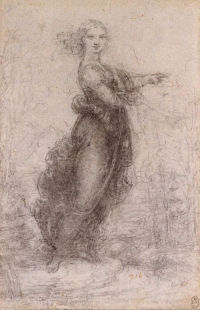Imagination and Invention Click on the thumbnails to explore the trail
Read more about this trail (expand)
The exercise of imaginative fantasy was as much an integral part of Leonardo’s mind as the discipline of scientific observation. For the artist, imagination was dependent upon an accurate understanding of observational input – a complete comprehension of the geometry of God’s design. Sensory impressions gained from observation were recombined by the artist’s ‘fantasia’ or imagination, to create new and credible forms

- Enlarge
- Zoom & explore
- The Royal Collection © 2005, Her Majesty Queen Elizabeth II
Young Woman (so-called pointing Lady) c1516
Leonardo argued at length for the superiority of the painter’s powers over those of the poet. This was part of an age-old debate known as the Paragone, a comparison between painting and the other arts.
The supremacy of painting was argued for primarily on the basis of the supremacy of sight over the other senses. After all, the eye was the “window to the soul”. The immediacy of sight was also an important factor in comparison to hearing, which “transmits the same thing but by a less noble means, carrying it more confusedly to the receptor of impressions and describing its configurations more slowly”.
Perhaps inspired by the poetry of Dante, the pointing lady in this drawing is the most poetic vision ever created by Leonardo. She has the romantic gracefulness of a “beloved lady” of the dolce stil nuovo, a type of contemporary Italian love poetry inspired by unrequited love.
While her windblown draperies recall the restless turbulence of water in Leonardo’s drawings, her confident pose and smiling expression seem to hold a promise of good things in a world to come.
In Leonardo's words
What poet can represent to you in words, oh lover, the true image of your ideal as faithfully as the painter will do? Who can show you the courses of rivers, the forests, valleys, and fields, and call up memories of past pleasures therein with more truth than the painter?
The visionary quality of this atmospheric drawing has given rise to the identification of this figure as Matelda, who suddenly appears to Dante and becomes his guide until the appearance of his beloved Beatrice at the end of the Purgatorio, canto xxviii.
Matelda appears as standing, and points out to him the river of Lethe and the rustling grove. While the drawing probably should not be interpreted as a literal illustration, its profoundly expressive quality can certainly be described as poetic. Leonardo’s writings contain many echoes of Dante, to whom he looked both for literary imagination and scientific information. However, it is notable that the figure’s costume is highly reminiscent of Botticelli’s illustrations for the Divine Comedy, done for Lorenzo di Pier Francesco de’ Medici, with whom Leonardo was in contact during 1502 and 1503.
- Medium Black chalk
- Size 21 x 13.5 cm
- Location The Royal Collection










